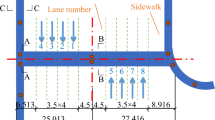Abstract
The box girder bridges constructed by prestressing the girders have been widely adopted to avoid the high dead load of the girders and for better performance during the service life. The loss of prestress may affect its performance and service life. Hence proper monitoring of such bridges with minimum efforts are useful for maintenance of the bridge. The correct estimation of the Impact Factor due to vehicle bridge interaction force is essential for designing such bridges. The presence of prestress in bridges influences the responses of bridges and vehicles moving over them. This paper provides the results of the finite element analysis of dynamic interaction between a vehicle and a simply supported pre-stressed box beam bridge. The interaction was conducted using ABAQUS software. Numerical simulations were conducted to show the effects of vehicle speed and road surface roughness profile on the mid-span displacement responses of the internal and external pre-stress box beams of the bridges. Thereafter, the influence of important parameters, namely, pre-stress force, road surface condition, and vehicle speed on the impact factor was investigated. Furthermore, it has been found that the maximum vertical vehicle acceleration response is sensitive to the prestress level and could be used to detect the percentage of prestress.















Similar content being viewed by others
References
Deng, L., Cai, C.S.: Development of dynamic impact factor for performance evaluation of existing multi-girder concrete bridges. Eng. Struct. 32, 21–31 (2010)
Olsson, M.: On the fundamental moving load problem. J. Sound Vib. 145(2), 299–307 (1991)
Stanišić, M.M.: On a new theory of the dynamic behavior of the structures carrying moving masses. Ing. Arch. 55, 176–185 (1985)
Akin, J.E., Mofid, M.: Numerical solution for response of beams with moving mass. J. Struct. Eng. 115(1), 120–131 (1989)
Yang, Y.B., Yau, J.D.: Vehicle-bridge interaction element for dynamic analysis. J. Struct. Eng. 123, 1512–1518 (1997)
Yang, Y.B., Lin, B.H.: Vehicle–bridge interaction analysis by dynamic condensation method. J. Struct. Eng. 121(11), 1636–1643 (1995)
Yang, Y.B., Wu, Y.S.: A versatile element for analyzing vehicle–bridge interaction response. Eng. Struct. 23, 452–469 (2001)
Yang, Y.B., Lin, C.W., Yau, J.D.: Extracting bridge frequencies from the dynamic response of a passing vehicle. J. Sound Vib. 272, 471–493 (2004)
Kwasniewski, L., Li, H., Wekezer, J., Malachowski, J.: Finite element analysis of vehicle–bridge interaction. Finite Elem. Anal. Des. 42, 950–959 (2006)
Zhang, N., Xia, H., Guo, W., Zhan, J., Yao, J., Cao, Y.: Vehicle-bridge interaction analysis of heavy load railway. Procedia Eng. 4, 347–354 (2010)
Oliva, J., Goicolea, J.M., Antolín, P., Astiz, M.Á.: Relevance of a complete road surface description in vehicle–bridge interaction dynamics. Eng. Struct. 56, 466–476 (2013)
Kortiš, J., Daniel, L.: Application of the Newmark numerical method with contact algorithm to the solution of the vehicle-bridge interaction. Procedia Eng. 153, 298–303 (2016)
Wang, H., Nagayama, T., Su, D.: Vehicle parameter identification through particle filter using bridge responses and estimated profile. Procedia Eng. 188, 64–71 (2017)
Wang, L., Jiang, P., Hui, Z., Ma, Y., Liu, K., Kang, X.: Vehicle-bridge coupled vibrations in different types of cable stayed bridges. Front. Struct. Civ. Eng. 10(1), 81–92 (2016)
Greco, F., Lonetti, P.: Numerical formulation based on moving mesh method for vehicle –bridge interaction. Adv. Eng. Softw. 121, 75–83 (2018)
Yang, Y.B., Zhang, B., Chen, Y., Qian, Y., Wu, Y.: Bridge damping identifiation by vehicle scanning method. Eng. Struct. 183, 637–645 (2019)
Kim, J.T.: Identification of prestress-loss in PSC beams using modal information. Struct. Eng. Mech. 17(3–4), 467–482 (2004)
Kovalovs, A., Rucevskis, S., Akishin, P., Kolupajevs, J.: Numerical investigation on detection of prestress losses in a prestressed concrete slab by modal analysis. IOP Conf. Ser. Mater. Sci. Eng. 251, 1–6 (2017)
Kim, S.H., Kim, J.H., Jung, C.Y., Ahn, J.H.: A verification of simplified analysis method for thermal prestressing in continuous composite bridge. Int. J. Steel Struct. 11(4), 427–443 (2011)
Zhong, H., Yang, M.: Prestress loss identification based on dynamic vehicle responses. J. Eng. Mech. 144(9), 1–15 (2018)
Çadraku, H.S., Jagxhiu, B.: Sustainability and functionality of railway network and its connecting facilities in Kosovo. J. Hum. Earth Future 1(3), 112–121 (2020)
Alonso, A.G., Sanchez, D.G., Aldaca, I.C.U., Castillo, C.L.: Novel method for an optimised calculation of the cross-sectional distribution of live loads on girder bridge decks. Civ. Eng. J. (2022). https://doi.org/10.28991/CEJ-2022-08-03-01
Soe, T.T.T., Khaing, S.U.: Evaluation of cable force changes effects on cable stayed bridge. Civ. Eng. J. 6, 11 (2020). https://doi.org/10.28991/cej-2020-03091609
ISO 8608, Second edition 2016-11-01, Mechanical vibration Road surface profiles—reporting of measured data.
Acknowledgements
The authors thank the National Institute of Technology Silchar for supporting this work.
Funding
There are no supporting funds for this work.
Author information
Authors and Affiliations
Corresponding author
Ethics declarations
Conflict of interest
There is no conflict of interest.
Additional information
Publisher's Note
Springer Nature remains neutral with regard to jurisdictional claims in published maps and institutional affiliations.
Supplementary Information
Below is the link to the electronic supplementary material.
Rights and permissions
Springer Nature or its licensor (e.g. a society or other partner) holds exclusive rights to this article under a publishing agreement with the author(s) or other rightsholder(s); author self-archiving of the accepted manuscript version of this article is solely governed by the terms of such publishing agreement and applicable law.
About this article
Cite this article
Nunia, B., Koli, M., Pandey, S. et al. Computational model on influence of prestress level on vehicle-bridge coupled vibrations. Int J Interact Des Manuf 17, 2731–2743 (2023). https://doi.org/10.1007/s12008-022-01149-9
Received:
Accepted:
Published:
Issue Date:
DOI: https://doi.org/10.1007/s12008-022-01149-9




